Yamaha EMX5016CF User Manual
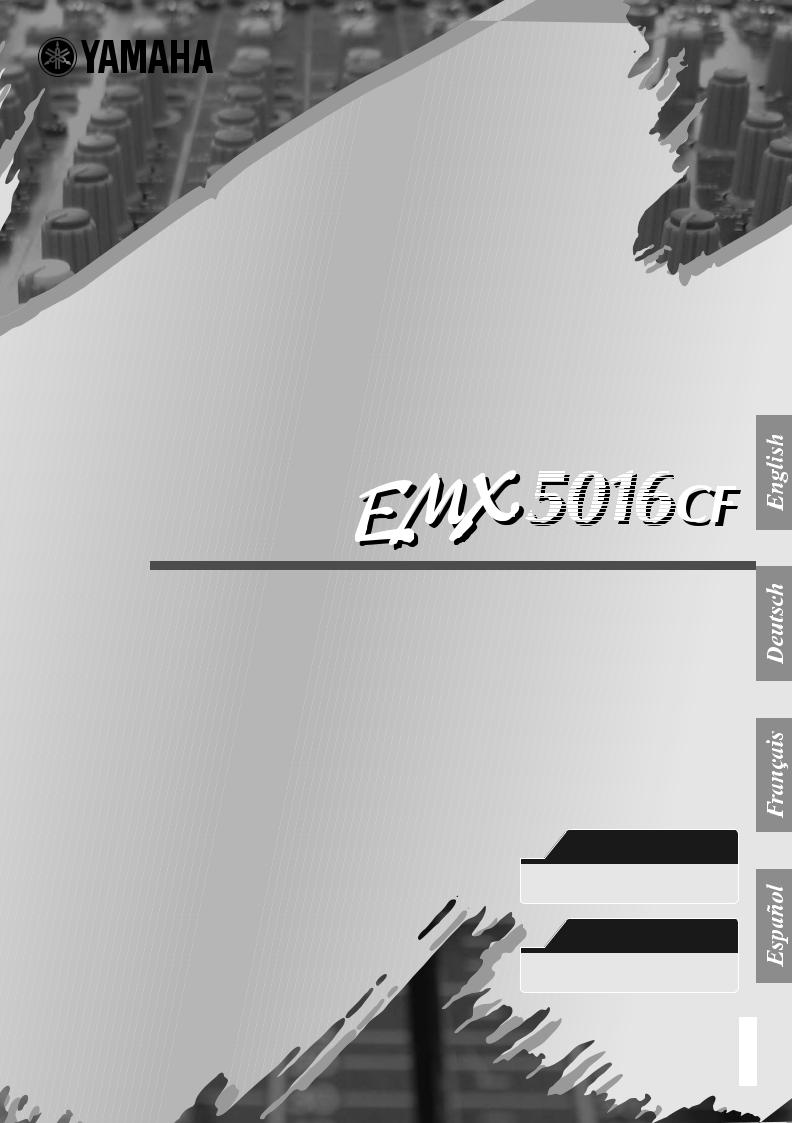
POWERED MIXERI
Owner’s’s Manuall
Bedienungsanleitungi l i
Mode d’emploi’ l i
Manuall de instruccionesi i
Quick Guide
Pages 7 to 11
Making the Most of Your Mixer
Pages 12 to 18
EN
DE
FR
ES
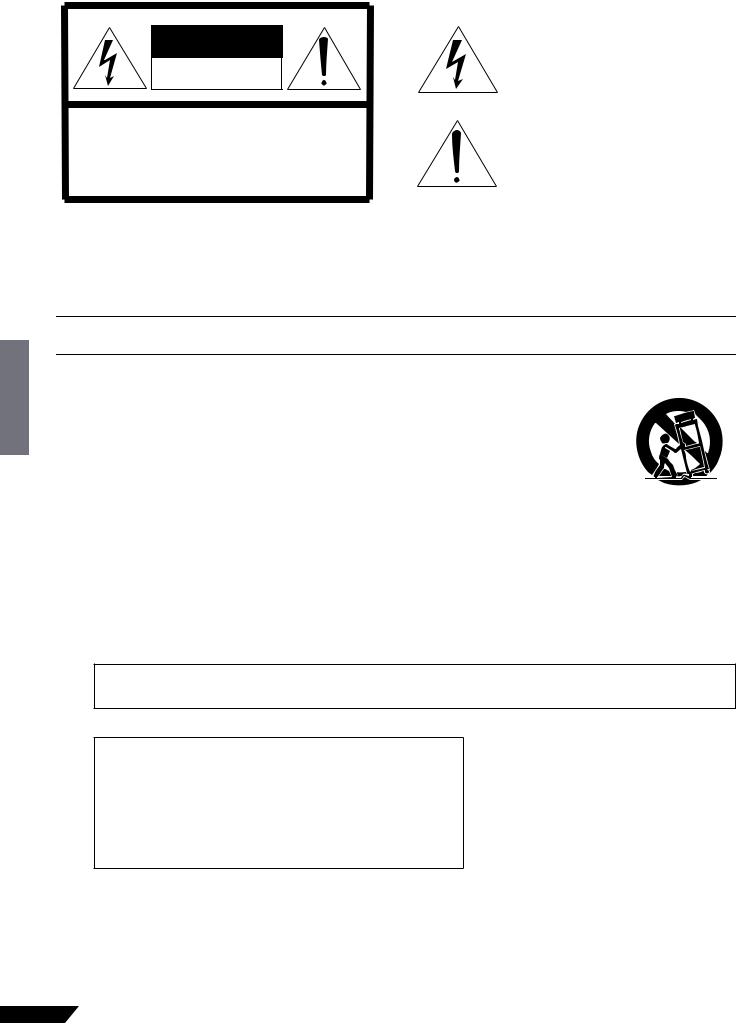
CAUTION
RISK OF ELECTRIC SHOCK
DO NOT OPEN
CAUTION: TO REDUCE THE RISK OF ELECTRIC SHOCK, DO NOT REMOVE COVER (OR BACK). NO USER-SERVICEABLE PARTS INSIDE. REFER SERVICING TO QUALIFIED SERVICE PERSONNEL.
The above warning is located on the rear of the unit.
Explanation of Graphical Symbols
The lightning flash with arrowhead symbol within an equilateral triangle is intended to alert the user to the presence of uninsulated “dangerous voltage” within the product’s enclosure that may be of sufficient magnitude to constitute a risk of electric shock to persons.
The exclamation point within an equilateral triangle is intended to alert the user to the presence of important operating and maintenance (servicing) instructions in the literature accompanying the product.
IMPORTANT SAFETY INSTRUCTIONS
1Read these instructions.
2Keep these instructions.
3Heed all warnings.
4Follow all instructions.
5Do not use this apparatus near water.
6Clean only with dry cloth.
7Do not block any ventilation openings. Install in accordance with the manufacturer’s instructions.
8Do not install near any heat sources such as radiators, heat registers, stoves, or other apparatus (including amplifiers) that produce heat.
9Do not defeat the safety purpose of the polarized or grounding-type plug. A polarized plug has two blades with one wider than the other. A grounding type plug has two blades and a third grounding prong. The wide blade or the third prong are provided for your safety. If the provided plug does not fit into your outlet, consult an electrician for replacement of the obsolete outlet.
10Protect the power cord from being walked on or pinched particularly at plugs, convenience receptacles, and the point where they exit from the apparatus.
11Only use attachments/accessories specified by the manufacturer.
12Use only with the cart, stand, tripod, bracket, or table specified
by the manufacturer, or sold with the apparatus. When a cart is used, use caution when moving the cart/apparatus combination to avoid injury from tip-over.
13Unplug this apparatus during
lightning storms or when unused for long periods of time.
14Refer all servicing to qualified service personnel. Servicing is required when the apparatus has been damaged in any way, such as power-supply cord or plug is damaged, liquid has been spilled or objects have fallen into the apparatus, the apparatus has been exposed to rain or moisture, does not operate normally, or has been dropped.
WARNING
TO REDUCE THE RISK OF FIRE OR ELECTRIC SHOCK, DO NOT EXPOSE THIS APPARATUS TO RAIN OR MOISTURE.
(98-6500)
IMPORTANT
Please record the serial number of this unit in the space below.
Model:
Serial No.:
The serial number is located on the bottom or rear of the unit.
Retain this Owner’s Manual in a safe place for future reference.
2 EMX5016CF Owner’s Manual

PRECAUTIONS
PLEASE READ CAREFULLY BEFORE PROCEEDING
* Please keep this manual in a safe place for future reference.
 WARNING
WARNING
Always follow the basic precautions listed below to avoid the possibility of serious injury or even death from electrical shock, short-circuiting, damages, fire or other hazards. These precautions include, but are not limited to, the following:
Power supply/Power cord
•Only use the voltage specified as correct for the device. The required voltage is printed on the name plate of the device.
•Use only the included power cord.
•Do not place the power cord near heat sources such as heaters or radiators, and do not excessively bend or otherwise damage the cord, place heavy objects on it, or place it in a position where anyone could walk on, trip over, or roll anything over it.
•Be sure to connect to an appropriate outlet with a protective grounding connection. Improper grounding can result in electrical shock.
Do not open
•Do not open the device or attempt to disassemble the internal parts or modify them in any way. The device contains no user-serviceable parts. If it should appear to be malfunctioning, discontinue use immediately and have it inspected by qualified Yamaha service personnel.
Water warning
•Do not expose the device to rain, use it near water or in damp or wet conditions, or place containers on it containing liquids which might spill into any openings.
•Never insert or remove an electric plug with wet hands.
If you notice any abnormality
•If the power cord or plug becomes frayed or damaged, or if there is a sudden loss of sound during use of the device, or if any unusual smells or smoke should appear to be caused by it, immediately turn off the power switch, disconnect the electric plug from the outlet, and have the device inspected by qualified Yamaha service personnel.
•If this device should be dropped or damaged, immediately turn off the power switch, disconnect the electric plug from the outlet, and have the device inspected by qualified Yamaha service personnel.
 CAUTION
CAUTION
Always follow the basic precautions listed below to avoid the possibility of physical injury to you or others, or damage to the device or other property. These precautions include, but are not limited to, the following:
Power supply/Power cord
•Remove the electric plug from the outlet when the device is not to be used for extended periods of time, or during electrical storms.
•When removing the electric plug from the device or an outlet, always hold the plug itself and not the cord. Pulling by the cord can damage it.
•Do not block the vents. This device has ventilation holes at the front and rear to prevent the internal temperature from becoming too high. In particular, do not place the device on its side or upside down. Inadequate ventilation can result in overheating, possibly causing damage to the device(s), or even fire.
•Do not use the device in the vicinity of a TV, radio, stereo equipment, mobile phone, or other electric devices. Doing so may result in noise, both in the device itself and in the TV or radio next to it.
Location
•Before moving the device, remove all connected cables.
•When setting up the device, make sure that the AC outlet you are using is easily accessible. If some trouble or malfunction occurs, immediately turn off the power switch and disconnect the plug from the outlet. Even when the power switch is turned off, electricity is still flowing to the product at the minimum level. When you are not using the device for a long time, make sure to unplug the power cord from the wall AC outlet.
•If this device is to be mounted in an EIA-standard rack, leave the back of the rack open and make sure that it is at least 10 cm away from walls or surfaces. Also, if this device is to be mounted with devices that tend to generate heat, such as power amplifiers, be sure to keep an adequate gap between this device and the heat-generating devices or install ventilation panels to prevent high temperatures from developing inside this device.
Inadequate ventilation can result in overheating, possibly causing damage to the device(s), or even fire.
•Avoid setting all equalizer controls and faders to their maximum. Depending on the condition of the connected devices, doing so may cause feedback and may damage the speakers.
•Do not expose the device to excessive dust or vibrations, or extreme cold or heat (such as in direct sunlight, near a heater, or in a car during the day) to prevent the possibility of panel disfiguration or damage to the internal components.
•Do not place the device in an unstable position where it might accidentally fall over.
Connections
•Before connecting the device to other devices, turn off the power for all devices. Before turning the power on or off for all devices, set all volume levels to minimum.
•Use only speaker cables for connecting speakers to the speaker jacks. Use of other types of cables may result in fire.
Handling caution
•When turning on the AC power in your audio system, always turn on the device or external power amplifiers LAST, to avoid speaker damage. When turning the power off, the device or external power amplifiers should be turned off FIRST for the same reason.
•Do not insert your fingers or hands in any gaps or openings on the device (vents, etc.).
•Avoid inserting or dropping foreign objects (paper, plastic, metal, etc.) into any gaps or openings on the device (vents, etc.) If this happens, turn off the power immediately and unplug the power cord from the AC outlet. Then have the device inspected by qualified Yamaha service personnel.
•Do not use the speakers or headphones for a long period of time at a high or uncomfortable volume level, since this can cause permanent hearing loss. If you experience any hearing loss or ringing in the ears, consult a physician.
•Do not rest your weight on the device or place heavy objects on it, and avoid use excessive force on the buttons, switches or connectors.
(5)-4
EMX5016CF Owner’s Manual |
3 |
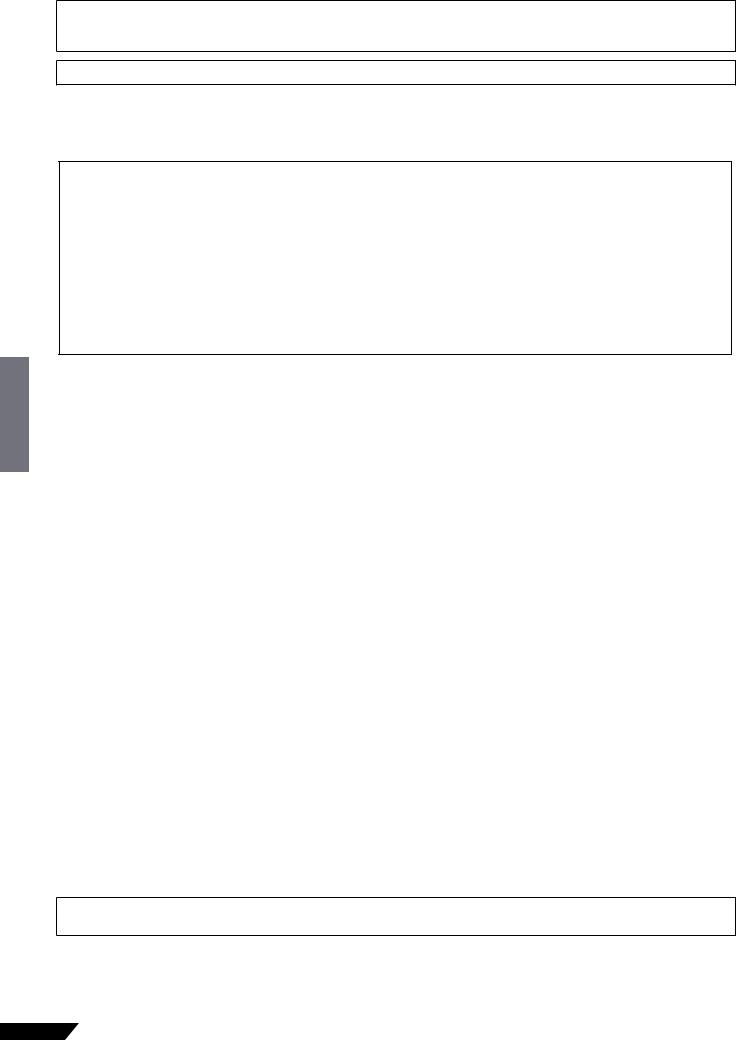
XLR-type connectors are wired as follows (IEC60268 standard): pin 1: ground, pin 2: hot (+), and pin 3: cold (-).
Use only Neutrik plugs (NL4) for connecting Speakon connectors.
Insert TRS phone jacks are wired as follows: sleeve: ground, tip:send, and ring:return.
Yamaha cannot be held responsible for damage caused by improper use or modifications to the device.
Always turn the power off when the device is not in use.
The performance of components with moving contacts, such as switches, volume controls, and connectors, deteriorates over time. Consult qualifi ed Yamaha service personnel about replacing defective components.
IMPORTANT NOTICE FOR THE UNITED KINGDOM
Connecting the Plug and Cord
WARNING: THIS APPARATUS MUST BE EARTHED
IMPORTANT. The wires in this mains lead are coloured in accordance with the following code:
GREEN-AND-YELLOW : EARTH
BLUE |
: |
NEUTRAL |
BROWN |
: |
LIVE |
As the colours of the wires in the mains lead of this apparatus may not correspond with the coloured markings identifying the terminals in your plug proceed as follows:
The wire which is coloured GREEN-and-YELLOW must be connected to the terminal in the plug which is marked by the letter E or by the safety earth symbol  or coloured GREEN or GREEN-and-YELLOW.
or coloured GREEN or GREEN-and-YELLOW.
The wire which is coloured BLUE must be connected to the terminal which is marked with the letter N or coloured BLACK. The wire which is coloured BROWN must be connected to the terminal which is marked with the letter L or coloured RED.
• This applies only to products distributed by Yamaha-Kemble Music (U.K.) Ltd. (3 wires)
FCC INFORMATION (U.S.A.) |
||
1. IMPORTANT NOTICE: DO NOT MODIFY THIS UNIT! |
regulations does not guarantee that interference will not occur in |
|
This product, when installed as indicated in the instructions con- |
all installations. If this product is found to be the source of interfer- |
|
tained in this manual, meets FCC requirements. Modifications not |
ence, which can be determined by turning the unit “OFF” and “ON”, |
|
expressly approved by Yamaha may void your authority, granted by |
please try to eliminate the problem by using one of the following |
|
the FCC, to use the product. |
measures: |
|
2. IMPORTANT: When connecting this product to accessories and/ |
Relocate either this product or the device that is being affected by |
|
or another product use only high quality shielded cables. Cable/s |
the interference. |
|
supplied with this product MUST be used. Follow all installation |
Utilize power outlets that are on different branch (circuit breaker or |
|
instructions. Failure to follow instructions could void your FCC |
fuse) circuits or install AC line filter/s. |
|
authorization to use this product in the USA. |
In the case of radio or TV interference, relocate/reorient the |
|
3. NOTE: This product has been tested and found to comply with the |
||
antenna. If the antenna lead-in is 300 ohm ribbon lead, change the |
||
requirements listed in FCC Regulations, Part 15 for Class “B” digi- |
lead-in to co-axial type cable. |
|
tal devices. Compliance with these requirements provides a rea- |
If these corrective measures do not produce satisfactory results, |
|
sonable level of assurance that your use of this product in a |
||
please contact the local retailer authorized to distribute this type of |
||
residential environment will not result in harmful interference with |
||
product. If you can not locate the appropriate retailer, please con- |
||
other electronic devices. This equipment generates/uses radio fre- |
||
tact Yamaha Corporation of America, Electronic Service Division, |
||
quencies and, if not installed and used according to the instruc- |
||
6600 Orangethorpe Ave, Buena Park, CA90620 |
||
tions found in the users manual, may cause interference harmful to |
||
The above statements apply ONLY to those products distributed by |
||
the operation of other electronic devices. Compliance with FCC |
||
Yamaha Corporation of America or its subsidiaries. |
||
|
||
|
|
|
* This applies only to products distributed by YAMAHA CORPORATION OF AMERICA. |
(class B) |
|
About this Manual
This manual is divided into two main sections, as follows.
■ Mixer Basics (starts on page 7)
Presents a general explanation of mixers and mixer concepts. Includes a Quick Guide that will help beginners get up to speed very quickly.
■ Reference (starts on page 19)
Provides detailed information about the EMX. Introduces the EMX features, identifies and explains the controls, indicators, and connectors; and explains how to set up the equipment.
*Within this manual, the term “EMX” refers to model EMX5016CF.
*Illustrations herein are for explanatory purposes only, and may not match actual appearance during operation.
*Company names and product names herein are trademarks or registered trademarks of their respective companies.
Copying of commercially available music or other audio data for purposes other than personal use is strictly prohibited by copyright law. Please respect all copyrights, and consult with a copyright specialist if you are in doubt about permissible use.
Specifications and descriptions in this owner’s manual are for information purposes only. Yamaha Corp. reserves the right to change or modify products or specifications at any time without prior notice. Since specifications, equipment or options may not be the same in every locale, please check with your Yamaha dealer.
4 EMX5016CF Owner’s Manual

Thank you for your purchase of this Yamaha EMX5016CF powered mixer. Please read through this manual carefully before beginning use, so that you will be able to take full advantage of your mixer’s superlative features and enjoy trouble-free operation for years to come. After reading the manual, please store it in a safe place.
Contents |
|
Features ............................................................................................................................................... |
6 |
Before Turning On the Mixer................................................................................................................ |
6 |
■ Mixer Basics |
|
Quick Guide ...................................................................................................... |
7 |
Getting Sound to the Speakers ............................................................................................................ |
7 |
Adding Some Reverb ......................................................................................................................... |
10 |
Using the Compressors to Enhance Vocals ...................................................................................... |
11 |
Making the Most of Your Mixer .................................................................... |
12 |
A Place for Everything and Everything in its Place ............................................................................ |
12 |
A Plethora of Connectors—What Goes Where?........................................................................ |
12 |
Balanced, Unbalanced—What’s the Difference? ............................................................................... |
13 |
How Do Balanced Lines Reject Noise? ............................................................................................. |
13 |
A balanced cable has three conductors: ............................................................................................ |
14 |
Signal Levels and the Decibel............................................................................................................ |
14 |
Making Better Mixes........................................................................................................................... |
15 |
Approaching the Mix—Where Do You Start?............................................................................. |
15 |
To EQ or Not to EQ.................................................................................................................... |
16 |
Ambience ................................................................................................................................... |
17 |
The Modulation Effects: Phasing, Chorus, and Flanging ........................................................... |
17 |
Compression .............................................................................................................................. |
18 |
■ Reference |
|
Front & Rear Panels....................................................................................... |
19 |
Controls on Each Channel ................................................................................................................. |
19 |
Digital Effects Section ........................................................................................................................ |
22 |
Master Section ................................................................................................................................... |
23 |
Rear Panel ......................................................................................................................................... |
28 |
Speaker Connections .................................................................................... |
29 |
2-channel connection ................................................................................................................. |
29 |
2-channel parallel connection .................................................................................................... |
29 |
Setting the GEQ with the FRC function ....................................................... |
30 |
Rack Mounting ............................................................................................... |
32 |
Setup ............................................................................................................... |
33 |
Troubleshooting............................................................................................. |
34 |
Specifications................................................................................................. |
35 |
EMX5016CF Owner’s Manual |
5 |

Features
Input Channels ................................................................................................ |
page 19 |
The EMX offers 12 monaural mic/line input channels (1 to 15/16) and four stereo input channel pairs (9/10 to 15/16), allowing you to freely mix inputs from microphones, linelevel devices, and stereo devices. For example, you can mix eight microphones with four stereo devices, or ten microphones with two stereo synthesizers.
High-Quality Digital Effects............................................................................ |
page 22 |
The mixer’s internal effector (two blocks) is in the same league as our SPX effector series, allowing you to create a rich range of variations with no external help. But of course you are also free to use the SEND EFF jacks to connect to an external effector of your choice.
Compressors ................................................................................................... |
page 18 |
Individual compressors are provided on channels 1 to 8. These let you compress the dynamic range of input signals such as vocals, guitars and bass, allowing you to bring down high signal peaks and boost lower level sounds. This feature helps reduce distortion and allows overall volume to be set higher, resulting in a stronger and more punchy sound. Moreover, a 3-band compressor is available for applying to the stereobus signal output, which enhances the overall output volume (MAXIMIZE function).
|
Internal Power Amp |
page 25 |
|
||
|
The internal amp makes it possible to connect the SPEAKERS jacks directly to non- |
|
|
powered speakers, with no need for an external amplifier in between. The rear panel |
|
|
offers two types of speaker connectors: phone jacks and Neutrik Speakon jacks. |
|
|
Graphic Equalizer and FRC............................................................................ |
page 30 |
|
This 9-band graphic equalizer adjusts the frequency characteristics of the Stereo-bus |
|
|
signal output. A convenient FRC function (Frequency Response Correction System) |
|
|
allows you to measure the frequency characteristics of the sound field, and automati- |
|
|
cally adjust the graphic equalizer settings according to the measurement results to |
|
|
compensate for any sound field anomalies. |
|
|
Feedback Suppressor..................................................................................... |
page 25 |
|
This function automatically checks for and removes feedback. |
|
Before Turning On the Mixer
■ Connecting to Power
1Be sure that the POWER switch is in the OFF position.
2Connect the included power cord to the AC IN connector on the rear panel.
3Plug the power cord into a standard power outlet.
■Turning the Unit On and Off
NOTE
•To prevent an unpleasant burst of noise from the speakers, you should power up the sound sources first, and then the other devices in order of their distance from the source (starting with the closest). → EMX unit → Amps (Powered speakers)
When turning power off, proceed in the opposite order.
• Before turning power on, make sure that the channel faders, ST master fader, AUX1/2 faders, ST SUB OUT control are all the way down.
Push the POWER switch in to turn the power ON.
The model name “EMX5016CF” is shown in the GEQ display. To turn the power off, push the POWER switch again, so that the indication goes off.
6 EMX5016CF Owner’s Manual

Mixer Basics
Quick Guide
Mixer Basics
 Getting Sound to the Speakers
Getting Sound to the Speakers
We begin by connecting up two speakers and generating some stereo output. Note that operations and procedures will vary somewhat according to the input devices you are using.
Input jacks
SPEAKERS jacks
|
|
|
|
|
|
|
|
|
|
|
|
|
|
|
|
|
|
|
|
|
|
|
|
|
|
|
|
|
|
|
|
|
|
|
|
|
|
|
|
|
|
|
|
|
|
|
|
|
|
|
|
|
|
|
|
|
|
|
|
|
|
|
|
|
|
|
|
|
|
|
|
|
|
|
|
|
|
|
|
|
|
|
|
|
|
|
|
|
|
|
|
|
|
|
|
|
|
|
|
|
|
|
|
|
|
|
|
|
|
|
|
|
|
|
|
|
|
|
|
|
|
|
|
|
|
|
|
|
|
|
|
|
|
|
|
|
|
|
|
|
|
|
|
|
|
|
|
|
|
|
|
|
|
|
|
1 Connect up the speakers and your input devices |
RIGHT |
|||||||||||||||||||||||||||||||||||||
(microphones, instruments, etc.). |
||||||||||||||||||||||||||||||||||||||
|
||||||||||||||||||||||||||||||||||||||
Use non-powered speakers and dedicated speaker cable. Connect one speaker to SPEAKERS jack A (A1 or A2), and the other to jack B (B1 or B2). Then connect your input devices (microphones, guitar, etc.) to the appropriate input jacks on the top panel. For details, see page 33.
 CAUTION
CAUTION
• Before connecting input devices to the EMX, be sure that all of these devices (including microphones) are powered off. And before turning the power to any device on or off, be sure to turn the volume of that device all the way down.
• Never connect both A and B jacks to a single speaker. Connection of both jacks to the same speaker may result in damage to the mixer.
NOTE |
WRONG!! |
|
We recommend that you avoid connecting electric instruments (such as electric guitars and basses) directly to the EMX. Instead, these instruments should be connected through an intermediary device such as a direct box, a preamp (guitar amp), or an amp simulator.
EMX5016CF Owner’s Manual |
7 |

Mixer Basics
Quick Guide
[26dB] switches GAIN controls
POWER AMP switch
PHANTOM switch
ON switches |
|
PEAK indicators |
POWER switch |
ST Master fader |
|
Channel faders |
|
2
3
4
5
Turn the Channel faders and the ST Master fader all the way down.
Set the POWER AMP switch to its upper position (to L-R).
For information about this switch, see page 25.
If you have connected input devices to channels 1 to 8, set the [26dB] switch ON (  ) or OFF (
) or OFF (  ) on each channel accordingly.
) on each channel accordingly.
If you have connected a line-level device, such as a keyboard or audio device, set the channel’s switch to the ON (  ). If you have connected a microphone or other mic-level device, set the switch to the OFF (
). If you have connected a microphone or other mic-level device, set the switch to the OFF (  ).
).
If you are using one or more condenser microphones for your inputs, set the PHANTOM switch to the ON position (  ).
).
 CAUTION
CAUTION
•Be sure to leave this switch off if you do not need phantom power.
•When using phantom power, do not connect any devices other than condenser microphones to the XLR input jacks. Other devices may be damaged if connected to phantom power. This precaution does not apply to balanced dynamic microphones, however, as these will not be affected by phantom power.
•To protect your speakers and ears: Before turning the PHANTOM switch ON or OFF, be sure to turn off the power to the mixer and to all other devices having internal amplifiers. We also recommend that you turn all output controls (Channel faders, ST Master fader, etc.) to minimum settings before operating the switch, to avoid risk of loud noises that could cause hearing loss or device damage.
8 EMX5016CF Owner’s Manual
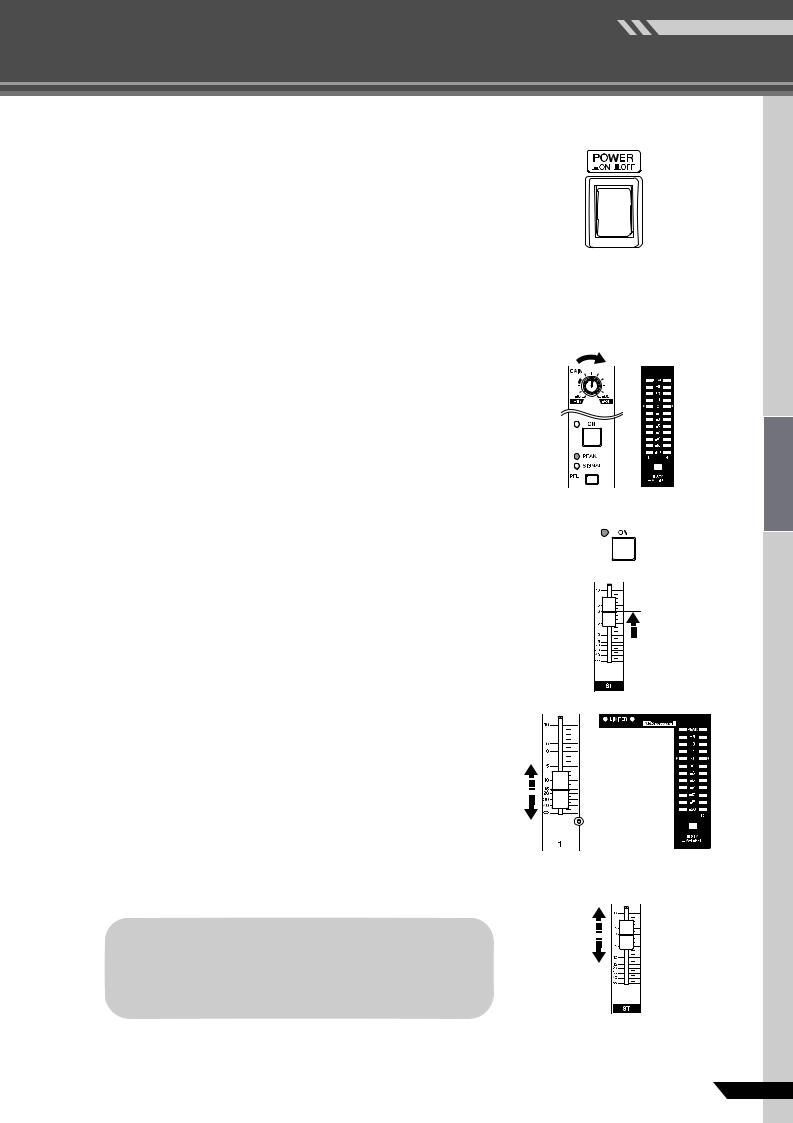
Mixer Basics
Quick Guide
6 Turn on the power.
First turn on the power to all connected devices other than powered speakers and amp, and then turn on the EMX itself. If using powered speakers or amps, turn these on last.
NOTE
To prevent an unpleasant burst of noise from the speakers, you should power up the sound sources first, and then the other devices in order of their distance from the source (starting with the closest).
For example: Sound source (external device) → EMX unit → Amps (Powered speakers)
7
8
9
10
Adjust the GAIN control for each channel you are using so that the PEAK indicator comes on only at about maximum input level.
NOTE
To use the LEVEL meter to get an accurate reading of the incoming signal level: Set the ST/AFL-PFL switch to AFL-PFL(  ) and turn on the PFL switch for each channel you are using. Adjust the GAIN controls so that LEVEL meter indication occasionally rises above the “
) and turn on the PFL switch for each channel you are using. Adjust the GAIN controls so that LEVEL meter indication occasionally rises above the “ ” (0) level. Note that the PHONES jack outputs the pre-faded signal from all channels whose PFL switch is ON, so that you can monitor these signals through the headphones.
” (0) level. Note that the PHONES jack outputs the pre-faded signal from all channels whose PFL switch is ON, so that you can monitor these signals through the headphones.
Turn the ON switch on.
Set the ST Master fader to the “0” position.
Adjust the channel faders on all occupied channels.
Adjust the faders while listening to the output from the speakers.
NOTE
•To use the LEVEL meter to view the level being input to the internal amp: Set the ST/AFL-PFL switch to ST(  ).
).
•Use the LIMITER lamps to check for clipping of the signal from the SPEAKERS jacks. Note that the LIMITER lamps will come on earlier than the level meter's PEAK indicators come on.
11 Adjust the overall volume of the ST Master fader.
 CAUTION
CAUTION
It is acceptable for the LIMITER lamps to flash on briefly at times, but if they remain lit continuously then there is risk of damage to your speakers or to the internal amp. Reduce the ST master fader setting so that these lamps do not stay on.
EMX5016CF Owner’s Manual |
9 |
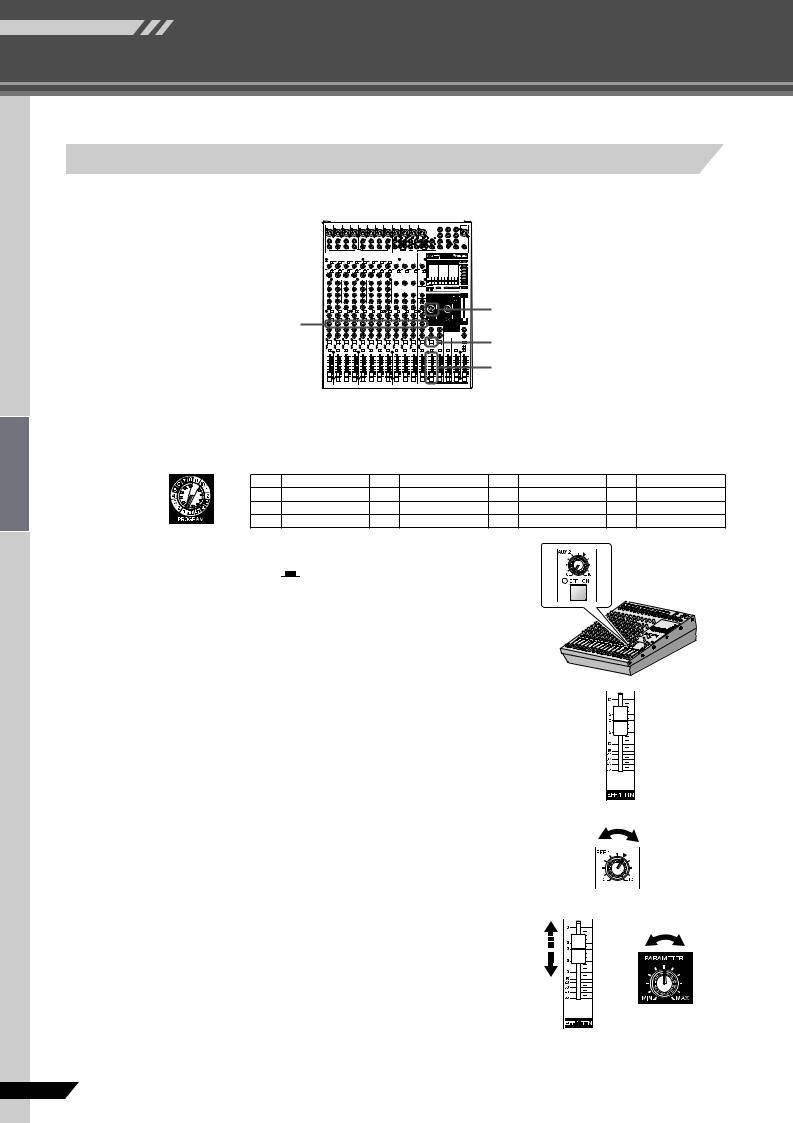
Mixer Basics
Quick Guide
 Adding Some Reverb
Adding Some Reverb
You can use the reverb effect to simulate the sound of a concert hall or jazz club.
PROGRAM dial
EFF1 knobs
EFF1 ON switch
EFF1 RTN fader
1 Turn the EFFECT1 PROGRAM dial to select the desired effect type.
To select a reverb effect, turn the dial to any value from 1 to 5.
1 |
HALL 1 |
5 |
SMALL STAGE 1 |
9 |
CHORUS |
C |
TREMOLO |
2 |
ROOM 1 |
6 |
VOCAL ECHO |
0 |
EARLY REF. |
D |
SINGLE DELAY |
3 |
PLATE 1 |
7 |
KARAOKE |
A |
GATE REVERB |
E |
DYNA FILTER |
4 |
LARGE STAGE 1 |
8 |
DELAY |
B |
REVERSE GATE |
F |
PITCH CHANGE |
2 To turn on the effector, set the EFF1 ON switch |
|
|
|
|
|||
to its ON position ( |
). |
|
|
|
|
|
|
The switch lights up when turned on. As an alternative to the ON switch, you can use a separately sold FC5 foot switch to toggle the effector on and off.
3
4
5
Set the EFF1 RTN fader to the “0” position.
Use the channel EFF1 knobs to adjust the effect depth for each channel.
Use the EFF1 RTN fader to adjust the overall effect depth.
Note that you can use the PARAMETER knob to adjust the characteristic sound of the selected effect. If you have selected a reverb effect, the knob adjusts the reverb time.
10 EMX5016CF Owner’s Manual
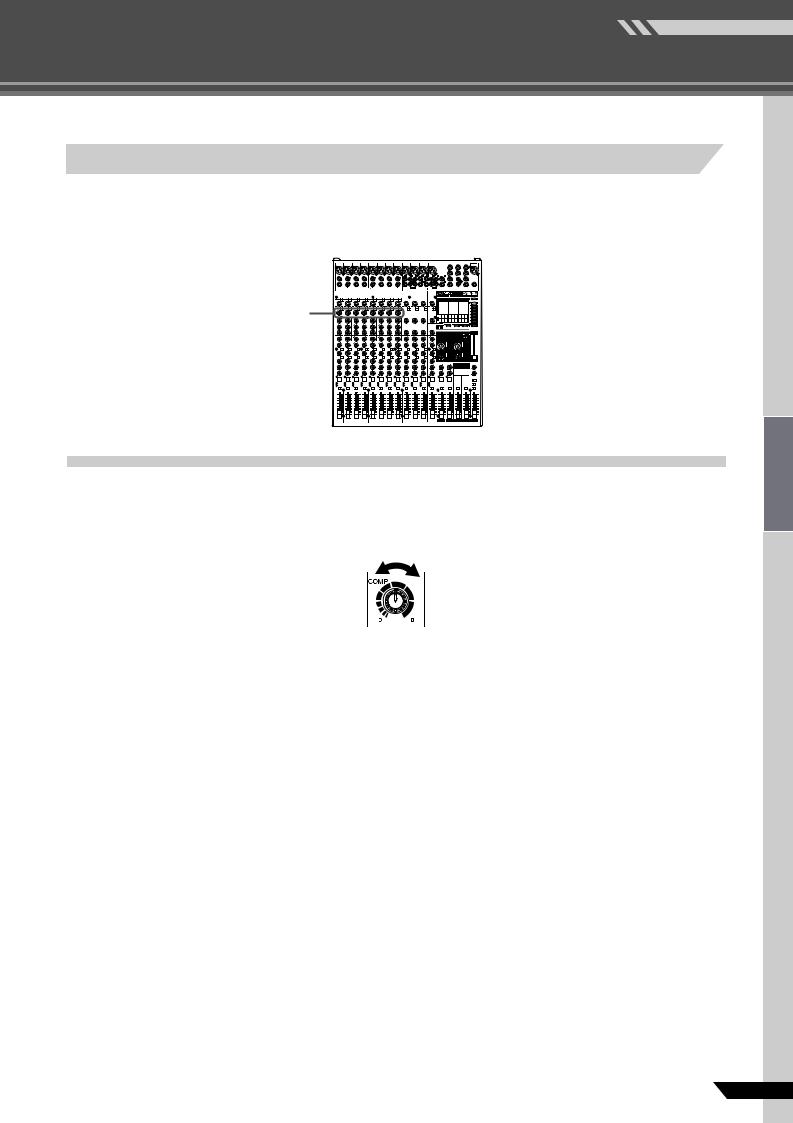
Mixer Basics
Quick Guide
 Using the Compressors to Enhance Vocals
Using the Compressors to Enhance Vocals
The compressor evens out the input level, reducing the level of loud passages and bringing up softer passages. The result is a cleaner sound where nuances remain audible and the lyrics are easier to hear.
COMP knobs |
1 Adjust the COMP knobs on the relevant channels.
Turn the knob clockwise to increase the compression. Avoid setting the value too high, as too much compression may result in howling. For more information about the compressors, see page 18.
EMX5016CF Owner’s Manual |
11 |
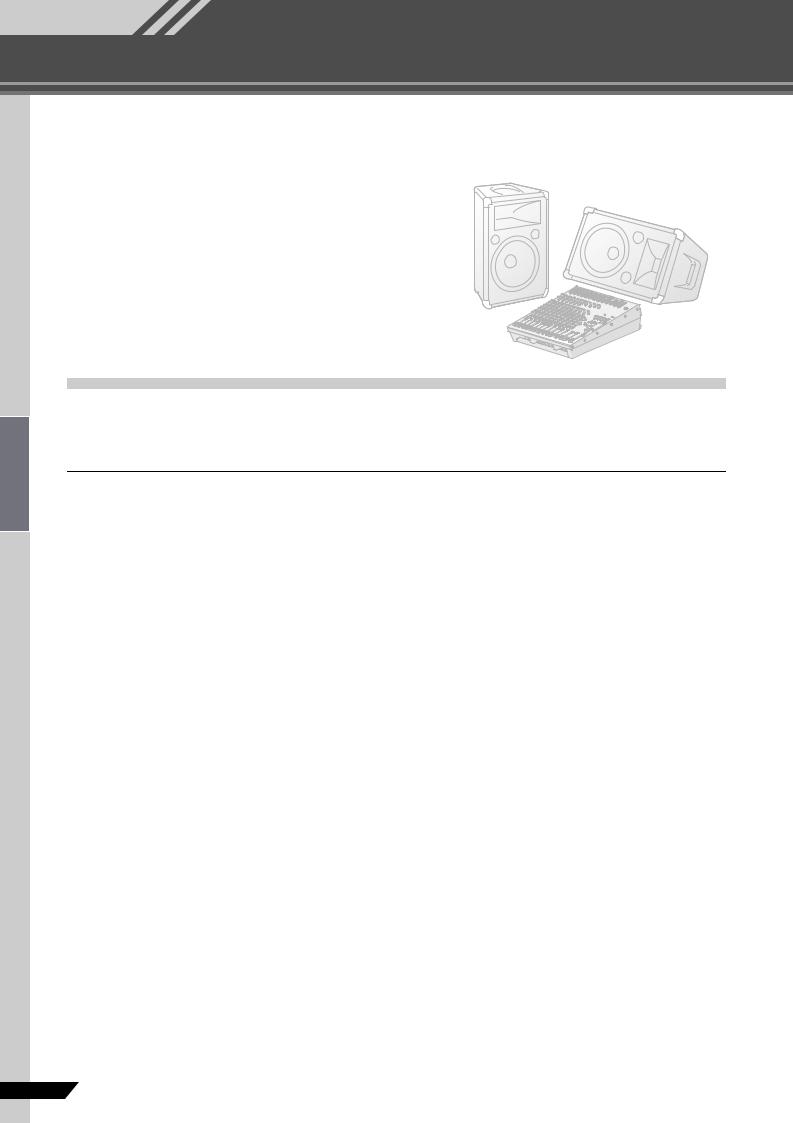
Mixer Basics
Making the Most of Your Mixer
An Introduction
You’ve got yourself a mixer and now you’re ready to use it. Just plug everything in, twiddle the controls, and away you go … right?
Well, if you’ve done this before you won’t have any problems, but if this is the first time you’ve ever used a mixer you might want to read through this little tutorial and pick up a few basics that will help you get better performance and make better mixes.
A Place for Everything and Everything in its Place
A Plethora of Connectors—What Goes Where?
Questions you’re likely to encounter when setting up a system for the first time might include “Why all these different types of connectors on the back of my mixer?” and “What’s the difference?”.
Let’s start by taking a look at the most common connector types.
The Venerable RCA Pin Jack
This is the “consumer connector,” and the one that has been most commonly used on home audio gear for many years. Also known as “phono” jacks (short for “phonogram”), but the term isn’t used much these days—besides, it’s too easily confusable with “phone” jacks, below. RCA pin jacks are always unbalanced, and generally carry a linelevel signal at –10 dB, nominal. You’re most likely to use this type of connector when connecting a CD player or other home audio type source to your mixer, or when connecting the output of your mixer to a cassette recorder or similar gear.
The Versatile Phone Jack
The name “phone jack” arose simply because this configuration was first used in telephone switchboards. Phone jacks can be tricky because you can’t always tell what type of signal they’re designed to handle just by looking at them. It could be unbalanced mono, unbalanced stereo, balanced mono, or an insert patch point. The connector’s label will usually tell you what type of signal it handles, as will the owner’s manual (you do keep your manuals in a safe place, don’t you?). A phone jack that is set up to handle balanced signals is also often referred to as a “TRS” phone jack. “TRS” stands for Tip-Ring-Sleeve, which describes the configuration of the phone plug used.
Sleeve
Ring
Tip
Stereo/TRS phone plug
Mono phone plug
The Sturdy XLR
This type of connector is generally referred to as “XLR-type,” and almost always carries a balanced signal. If the corresponding circuitry is designed properly, however, XLR-type connectors will also handle unbalanced signals with no problem. Microphone cables usually have this type of connector, as do the inputs and outputs of most professional audio gear.
Male
Female
12 EMX5016CF Owner’s Manual
